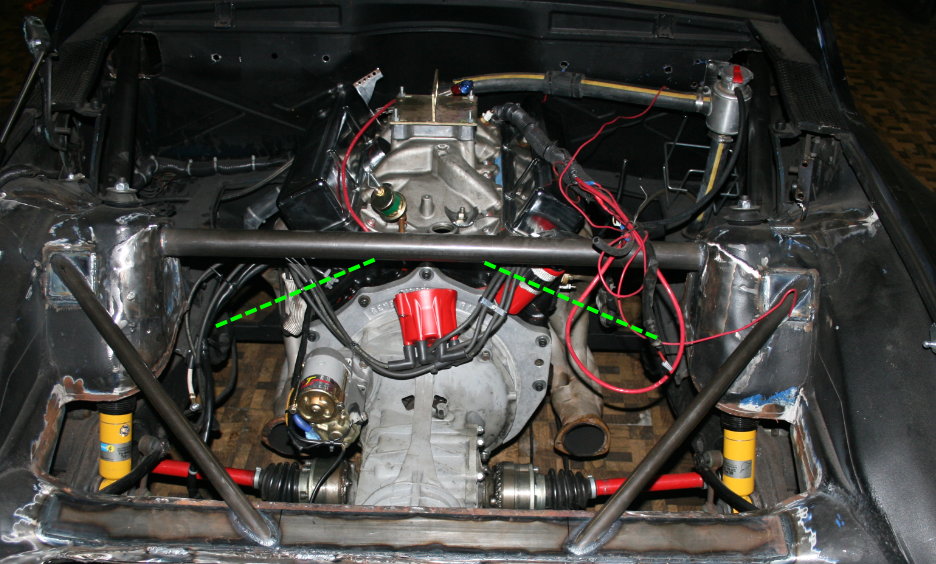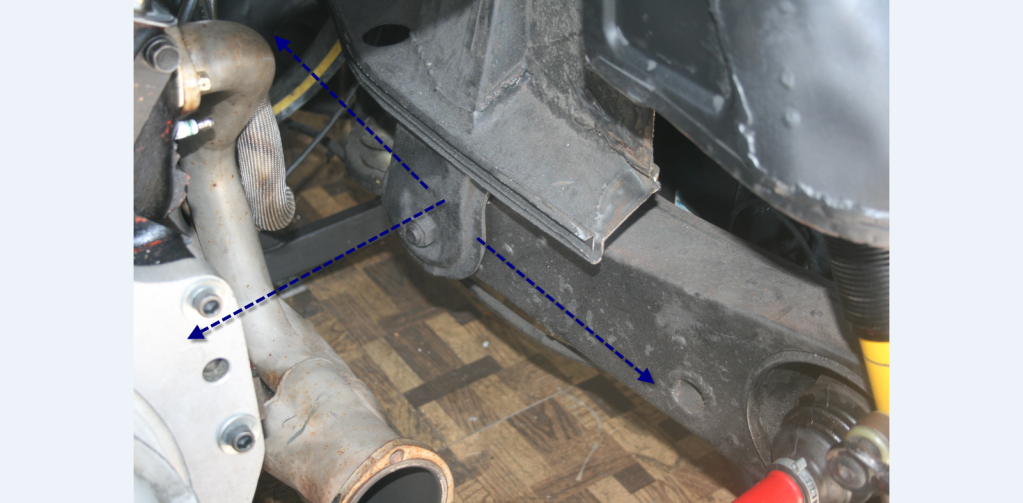wallys914
Apr 9 2011, 12:08 PM
I am looking at beefing up and bracing the suspension console/ear, with the standard stiffening kit, and was thinking how could if needed tie it in the the cage for added support. In thinking thinking this I starting thinking in what direction does the console flex, I see everyone mounting the suspension console to the firewall, is this the direction in which it flexes? Would it matter if you are handling the flex with a push or pull method, e.g. - from the firewall to the console vs. shock tower connector to the console ? Like below


r_towle
Apr 9 2011, 12:59 PM
ConeDodger
Apr 9 2011, 01:07 PM
I know this is totally smartass but it really depends on your rust...

Doesn't look like you have any.

r_towle
Apr 9 2011, 01:11 PM
Rob is right...
But most of the bracing I have seen goes from the ear to the lower firewall.
As you move forward under acceleration , the tire wants to toe out...so it pushes the inner ear forward, and toward the outside slightly.
Rich
wallys914
Apr 9 2011, 01:38 PM
Thanks for the historical article that kept me busy for 30 minutes.

r_towle
Apr 9 2011, 02:06 PM
There is another one I could not find that had pictures and charts and all sort of cool stuff showing the rotation of the arm, what the toe angle was at every step...it was a great thread...not sure if that was the one...wanted to save the 30 minutes
RIch
Dave_Darling
Apr 9 2011, 02:41 PM
Bracing the ear forward will help with both forward and aft flex. The inner and outer suspension mount points transmit the "push" of acceleration to the car. So they both get shoved forward; with a V8 they will probably get a whole lot of push! The tires pulling forward will make the rear suspension try to toe IN (I believe), which will put some more push forward on the outer pickup and back on the inner ear.
I'm thinking that you get thrust reversals on that inner ear, with any initial acceleration pulling it back, followed very quickly by it being pushed forward for a longer period of time. Braking is done more by the front wheels than the rear, so you would not have as much force going the other way under braking, but there would still be some most likely.
Cornering loads will usually push the inner ear toward the center of the car, and also push it upward. The ear is reasonably supported in those directions, I think. But if you want to, I'm sure you can figure out some way to stiffen it in those directions as well.
--DD
J P Stein
Apr 9 2011, 07:18 PM
The forces go fore & aft, inboard & outboard.
As I see it running a tube forward to the bulkhead is false security for a couple of reasons. The area on which most people put their doubler plate is thin sheet metal. IMO it is subject to oil-caning....wiggle.
The straight tube does nothing for loads pushing inboard or outboard
Unless you have a fitted bolt on the Hiem (if used)joints there is another place for wiggle.
BTW, I have been running 10 inch rear slicks for 6 (or so) years & running rough venues. Never had the outboard trailing support move using factory torque on em'.
The car got alignment checks at the start of each season. The toe hangs in there.
IMO, the best thing to do for a street car is to strenghten the inner ear and leave the rest alone. The inner ear is a shitty design. For a race car...knock your self out for several years then come back & tell us how it worked.
r_towle
Apr 10 2011, 08:37 AM
JP, post a pic of the tube you put in...it has some good design though to allow access....
Personally I think the tube forward to the firewall, and a properly attached thick plate at the firewall will do the trick for forward and aft movement..
For side to side, it seems the best thing to do is to add steel to the outward side of the inner ear to add another layer and give it more strength...
Then I would suggest that at some point, maybe 11 or 12 inch rubber, you have reached the limit of the chassis and you need to think about a different rear suspension to handle the stress of wider rubber.
Or, stick with the thinner tires and learn to drive it with a bit more slip from the rubber.
Rich
J P Stein
Apr 10 2011, 09:05 AM
The angled tube is not for clearance but for a bit of load taking for the in/out movement + fore & aft. Admittedly not a complete cure for the former. At the time all options were considered & this was the best I could come up with. I would have liked to support the aft end of the ear also but I could find no way. The attach points & subsequent length of a tube on the back side would allow an excess of a pendulum effect and a horrible angle for the purpose.

Recently I did see a boxed ear that looked superior to what I did. A race car restore on this site by gms.
My fix vs his. I ain't the sharpest knife in the drawer but I know a good idea when I see one.
This is a "lo-fi" version of our main content. To view the full version with more information, formatting and images, please
click here.



